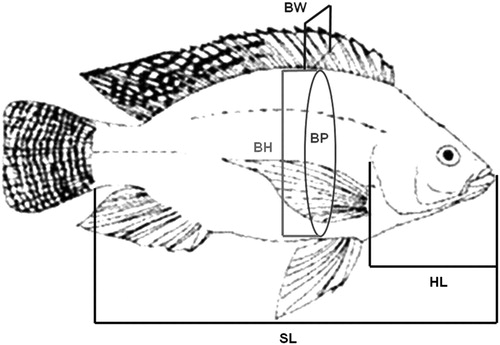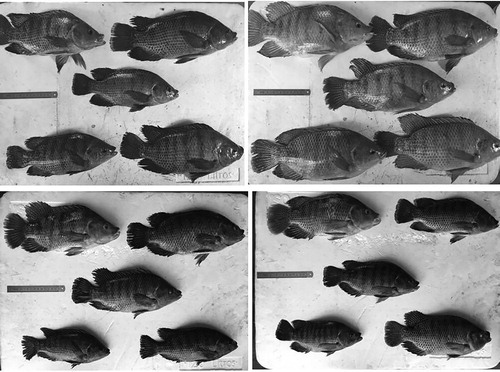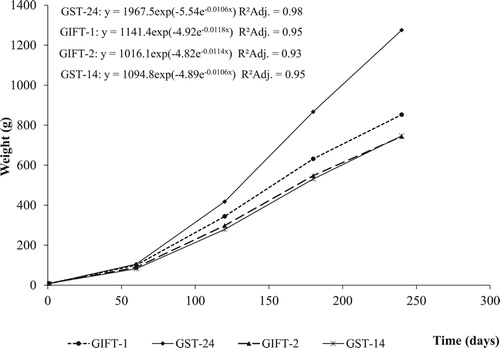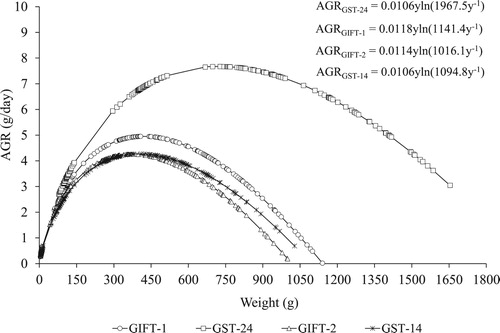 ?Mathematical formulae have been encoded as MathML and are displayed in this HTML version using MathJax in order to improve their display. Uncheck the box to turn MathJax off. This feature requires Javascript. Click on a formula to zoom.
?Mathematical formulae have been encoded as MathML and are displayed in this HTML version using MathJax in order to improve their display. Uncheck the box to turn MathJax off. This feature requires Javascript. Click on a formula to zoom.ABSTRACT
The aim of this study was to evaluate the performance of three Nile tilapia strains in Brazil compared to Genomar Supreme™ Generation 24 from the Philippines. Tilapia fingerlings, male population, of approximately 8 g which were cultivated in water recirculation systems containing 0.5 m3 tanks, density of 60 fish m−3, with four replicates (tanks). The fish will be fed three times a day with the same commercial feed for each particular growth phase according to biomass in each tank. Five fish from each tank were sampled at the start and 60th, 120th, 180th and 240th days of cultivation. They were determined the weight gain, feed conversion and homogeneity of batch in each period. The Gompertz model given by was fit and it was calculated the absolute and relative growth rate. The weight and age at inflection point were calculated too. The improvement programme from Genomar in the Philippines brings tilapia strain with better growth rate and performance when compared with the one commercialized in Brazil. This Philippine strain constitutes an important potential to improve tilapia farm in Brazil. However, the use of this genetics needs to be accomplished in this country.
1. Introduction
The increasing demands for healthy food among the world population, including Brazil, have provided the tilapia culture development and Nile tilapia (Oreochromis niloticus) is the most common between producers and freshwater aquaculture (dos Santos et al. Citation2008). The searching for tilapia strains of superior performance has required assessments of cultivation in different environments.
The Genetically Improved Farmed Tilapia (GIFT) and Genomar Supreme Tilapia (GST) are two selective breeding programmes which have generally been implemented in Asia under relatively intensive culture systems where the fish are provided with formulated feeds (Ponzoni et al. Citation2011). GIFT tilapia is the most popular strain in Brazil, having arrived in 2005 from the World Fish Center, Malaysia, and spread by many suppliers in Brazil. The GIFT programme involved four wild populations of tilapia from Egypt, Ghana, Kenya and Senegal, and four confined populations introduced in the Philippines from Israel, Singapore, Thailand and Taiwan (Bentsen et al. Citation1998).
Since GIFT strain has spread worldwide, independents and different programme of selection were added resulting in new strains. The major tilapia strains commercialized in Brazil today were originated from GIFT programme. The GIFT strain is thus a valuable genetic resource for the aquaculture industry. Therefore, a systematic approach of brood stock management and dissemination should be implemented to ensure effective use and sustainability of this strain. Furthermore, the strain continues to offers ample scope for further genetic improvement.
Genomar Supreme Tilapia™ is the prosecution of the GIFT breeding in the Philippines. Genomar provided applying DNA-fingerprinting as an identification tool and inserted the rotative mating to complete the generation after nine monthly batches. Several advantages in DNA-typing are increased selection intensity, shorter generation interval and operational benefits (El-Sayed Citation2006). Year after year GST has improved its gains and the Generation 14th has been the unique GST genetic commercialized in Brazil since 2002.
The objective of this study was to evaluate the performance of three Nile tilapia (O. niloticus) strains in Brazil compared to Genomar Supreme™ Generation 24 from the Philippines. A set of weight data according to the age was fitted in exponential models, enabling the obtention of important parameters of biological interpretation and carcass characteristics.
2. Material and methods
2.1. Location, biological material and facilities
The experiment was carried out from April to November in a greenhouse with controlled environmental conditions and natural photoperiod, in the Southeast region of Brazil, São Paulo State at 22°11’ South latitude, 51°23’ West longitude and 458.3 m altitude.
Tilapia fingerlings were sourced from 4 different suppliers representing relevant Nile tilapia strains. Two of them were sourced from GST generation 14th (GST-14, that arrived in Brazil in 2002) and generation 24th (GST-24, imported from the Philippines to this research). Another one was a continuation of GIFT programme with the population that arrived in Brazil in 2005 (GIFT-2) and another resulting of crossing in a breeding nucleus in North America since 2010 (GIFT-2, commercialized in Brazil). Fingerlings with similar age were grown until 8.5 g before the beginning of the experiment. During the experiment, fish were grown in water recirculating systems containing tanks of 0.5 m3, at a starting density of 120 fish m−3, with four repetitions per strain (total of 16 tanks). A constant flow of water of 1500 L h−1 was maintained in each tank. The systems were supplied with temperature control, mechanical filtration and ultraviolet treatment.
The fish density was corrected with the time because of the increase of the biomass. The variation on fish density and biomass is shown in . The density-related culling was done by taking a random sample from the tanks. The water temperature of the recirculation system was maintained at 26°C. The dissolved oxygen and temperature were monitored daily (around 10:00 am) and pH, hardness, alkalinity, ammonia, nitrite, and nitrate weekly. The maximum to ammonia, nitrite and nitrate were 1.01 mg L−1 (0.75), 0.53 mg L−1 (0.26), 74.50 mg L−1 (55.35), respectively, and they were found after day 120th of cultivation. The medium and standard deviation to temperature, oxygen, pH, alkalinity and hardness were 26.6 (1.96), 4.89 (0.86), 7.54 (0.66), 213.93 (22.38), 0.55 (0.30), respectively.
The fish were fed three times a day with the same specific diet for each growth stage, the amount provided in accordance with the biomass of the tank. Forty fish from each strain (ten fish per tank) were weighed at days 0, 60th, 120th, 180th and 240th of cultivation after going through a fasting period of 24 h. The biomass of each tank was measured every 15 days to ensure correct food supply.
2.2. Performance evaluation and carcass characteristics
Performance measures were determined such as weight gain, feed conversion and homogeneity of the batches (coefficient of variation) in each period.
Body morphometric measurements were determined too. They were assessed as to standard length (SL), head length (HL) body height (BH), body width (BW) and body perimeter (BP) in the middle portion of the body (taken on the 7th ray of the dorsal fin) as shown in .
Figure 2. Morphometric evaluation of tilapias. SL – standard length, HL – head length, BH – body height, BW – body width, BP – perimeter of the body.

At the end of the experiment, the fish were anesthetized and euthanized after having passed a 24-hour fast. The weight was obtained from the head, viscera, visceral fat, carcass, fillet, skin and waste following dos Santos et al. (Citation2007) and liver. The viscerosomatic (IVS) and hepatosomatic (HSI) index and the visceral fat were calculated as a percentage of the weight of the viscera and liver in relation to the weight of the fish.
The fat fillet was determined as well. Fillet was frozen, milled and homogenized in order to determine the ethereal extract (Soxhlet method), according to AOAC (Citation2000). The values obtained represented an average of four fish/tank and the results were expressed as a percentage (%).
2.3. Data analysis
ANOVA was performed according to a completely randomized design with four treatments and four replicates (tanks) for performance and carcass characteristics measures, except to fillet fat content. Tank effect was tested but did not show significance (P > .05). Due to the individual differences in fat content, the variance analysis was performed in 12 fish for each strain (3 fish per tank).
The study of the growth was done by fitting all the fish weight data to the exponential model, according to dos Santos et al. (Citation2013), using the Gompertz model given by . In addition, they were measured the absolute (AGR) and relative (RGR) growth rates, given by Kyln (u−1) and Kln (u−1), respectively, and u = yA
−1, weight and age at inflection points, given by Ae
−1 and (lnB)K−1, respectively (Fitzhugh Citation1976; Gamito Citation1998).
Confidence intervals were used to compare the model parameters for each strain using α = 0.05. Equations and R 2 Adjusted statistic were provided. The estimates were obtained by Weighted Least Squares (Draper and Smith Citation1998) according to dos Santos et al. (Citation2008).
3. Results
The initial weight was 8.72 (1.08), 8.60 (0.55), 8.70 (0.83) to Brazilian tilapia strains and 8.14 (0.29) to GST-24 ones and they were similar (P > .05). The results of the performance analyses are presented in . It was observed that at day 60th, 120th, 180th and 240th of cultivation the final weight, weight gain and feed conversion were better in GST-24 strain when compared to Brazilian strains (P < .05). The performances of the Brazilian strains were similar between them. GST-24 also showed the best batch homogeneity indexes (P < .05). On the day 240th of cultivation the standard of the baths is shown in .
Figure 3. Random sample image of fish of each strain at day 240th of cultivation. (A) GIFT-1; (B) GST-24; (C) GIFT-2 e (D) GST-14 (ruler size = 15 cm).

Table 1. Medium of performance variables and standard deviation from tilapia strains at different period of cultivation in aquaculture recirculation system.
The parameters estimated of the Gompertz model are presented in . It was noticed that GST-24 strain showed the highest estimate of ‘A’ (1967.5 g). This estimate was similar between Brazilian’ strains. The growth rate ‘K’ related at the maturity did not present differences on the estimates between strains. The model adjustment is provided in .
Figure 4. Gompertz growth model of Nile tilapia strains. Each point represents the mean estimates of forty fish of each strain.

Table 2. Estimate parameters ‘A’ and ‘K’ and confidence intervals of the Gompertz growth model of Nile tilapia strains.
The weight, age at the inflexion point and the maximum AGR are shown in . GST-24 strain presented higher weight (723.8 g), age (161.5 days) and absolute growth rate (7.67 g day−1) at the inflexion point when compared to Brazilian’ ones. GIFT-1 presented weight (419.9 g) and AGR (4.96 g day−1) slightly superior to GIFT-2 and GST-14. Interestingly, in GIFT-1, it was observed the smallest age at inflexion point (135.13 days).
Table 3. Values of weight (g), age (days) and absolute growth rate (g day−1) at inflection point from Nile tilapia strain cultivated in recirculation aquaculture system throughout 240 days.
presents the morphometrics variables and their relationships from different tilapia strains (P < .05). The Supreme strain showed the highest morphometrics measurements follow its higher final weight. GIFT-1 had higher morphometrics measurements than GIFT-2 and GST-14, except to body width.
Table 4. Medium of morphometric variables (cm), their relationships and standard deviation from tilapia strains at day 240th of cultivation.
displays the visceral and carcass characteristics in relation to total body weight (live weight). The hepatossomatic index was similar between tilapia strain (P > .05). However, smaller viscerossomatic index, visceral fat were found in GIFT-1 and GST-24 (P < .05). Moreover, GST-24 strain presented the smallest % head and the highest fillet yield (P < .05). Although higher and heavy fish could present more fillet fat as occurred in GIFT-1 (0.78%) compared to GIFT-2 (0.47) and GST-14 (0.51), Supreme strain (the heaviest strain) presented fat fillet in intermediary content (0.61).
Table 5. Medium and standard deviation of different body variables (Var), in relation to final weight from tilapia strains at day 240th of cultivation.
4. Discussion
Differently from other world regions, South America has not worked on tilapia breeding as effectively as North America and Asia. However, the environmental conditions and water sources, added to the consumer market (as in Brazil), transform the tilapia culture as the highest growth potential in the world.
dos Santos et al. (Citation2013) evaluated the performance of three tilapia strains, Red, GIFT and Supreme (generation 14th). On day 120th, the final weight was 288.82 and 288.59 g for GIFT and Supreme, respectively, and they were similar in this study to GIFT-2 and GST-14. This may mean that the gains obtained by the tilapia breeding process in Brazil have not had effectiveness in the last few years.
In fish farming, differences in size among individuals are generally associated with competition for food within a group and the resulting feeding hierarchy, and phenotypic coefficient of variation (CV) for body weight, apart from indicating variation of the trait, has been used as an indicator of competitive interactions within a population. For the GIFT strain, the CV ranges from 40 to 60%, which is considered a high value (Ponzoni et al. Citation2005; Marjanovic et al. Citation2016).
Marjanovic et al. (Citation2016) reported that although good management during the grow-out phase could reduce the CV, its average value across eight generations of GIFT remained at around 40%. The process of sorting fish into size groups is a common approach in fish farming to decrease phenotypic variation in body size and weight (Marjanovic et al. Citation2016). If fish are not graded, the large variation in weight and size at harvest reduces their market value and has animal welfare consequences (Khaw et al. Citation2016). In this work, any process to sort or grad fish was used and the results indicate that the Brazilian strain has a good homogeneity (CV about 20%) when compared to other studies with GIFT strain. Additionally, GST-24 strain represents a considerable gain in this aspect (CV about 10–15%).
The Gompertz model fitted to weight data from GIFT-1, GST-24, GIFT-2 and GST-14 tilapia strains had high R 2Adjusted, presenting applicable estimates and trustworthiness. More than an adequate and non-constant growth rate, this model can present important parameters with biological interpretation as absolute and relative growth rate (AGR and RGR). and show the AGR (g day−1) and RGR (%) of the strains.
Figure 5. Absolute growth rate (AGR) of the Nile tilapia strains. Each point represents the estimate of each observation (n = 200 of each strain).

Figure 6. Relative growth rate (RGR) of the Nile tilapia strains. Each point represents the estimate of each observation (n = 200 of each strain).

GST-24 strain presented the highest AGR. In this strain, fish above 300 g had AGR about 4–8 g day−1 while in the Brazilian ones were 3–5 g day−1. Differently from the Supreme strain, fish above 600 g in Brazilian ones presented intensive decrease in AGR. In addition, while fish about 1000 kg in Brazilian ones showed AGR < 1 g day−1, GST-24 strain presented AGR about 4 g day−1. Fish above 300 g from GST-24 also presented higher RGR when compared to Brazilian ones.
According to dos Santos et al. (Citation2013), different variables as growth rate, mortality, resistance for environmental conditions, food intake, feed conversion and fingerlings uniformity influence the relation weight-age and studies of growth fitting growth curves are an important tool to improve the production. Genetically improved tilapia have shown faster growth when compared to the wild population, and this can cause changes in quality of carcass and flesh due differences in the muscle and adipose tissue growth (dos Santos et al. Citation2012), morphometry, metabolic rate and size of different tissue and organs.
Some differences between strains were found in the relation HL/SL (head length/standard length) and BP/SL (body perimeter/standard length). GST-14 showed the smallest relation HL/SL, and was similar to GST-24 strain. The highest relation BP/SL was found in GIFT-1 and GST-24 strain. Our previous researches indicate that the smallest relation HL/SL and highest relation BP/SL in fish is interesting because of the flesh yield. GST-14 showed the smallest relation BH/SL (body height/standard length).
Harvest weight is the most efficient criterion to improve the overall performance of the fish compared to other body trait measurements such as length, depth and width (Nguyen et al. Citation2007), and the best predictor of fillet weight, a carcass trait of great importance in fish (Nguyen et al. Citation2010). Body shape, weight and relationship between morphometric variables has been studied because the relation not only fillet weight but also fillet and carcass yield (Rutten et al. Citation2004; Gomiero et al. Citation2009). de Oliveira et al. (Citation2016) has demonstrated that the process to increase growth rate had small, but slowly constant effect in body shape traits; and in the long term, the fish would have become rotund.
According to Ponzoni et al. (Citation2011), GIFT strain emerged as a valuable strain for filleting, but not because of an advantage in fillet yield (which was very similar between strains), but rather because of its greater fillet weight owing to its greater growth rate. The fillet yields reported in some studies by ranged from 26.66% to 38.89% (Rutten et al. Citation2004; Ponzoni et al. Citation2006; Khaw et al. Citation2016), and are in agreement with the values reported in this study (29.55–32.25). Differences in fillet traits and quality (as fat content) have not been found in tilapia strain (Ponzoni et al. Citation2006; Khaw et al. Citation2016) and have been little studied.
The smallest viscerossomatic index and visceral fat were found in GIFT-1 and Supreme and this is interesting in energy economy to muscle mass growth. However, the differences found in the yield of fillet of tilapia among the several studies can be due to the efficiency of the machines or manual dexterity of the operator, method of filleting and some characteristics intrinsic to the raw material.
GIFT-2 and GST-14 are two strains spread in farms in Brazil and have similar characteristics of growth and carcass. GIFT-1 has a good performance and its production gives some advantage to farmers. Actually, the data presented in this work may not represent the maximum growth of the tilapia strains if we consider other system production as a cage or ponds. Other studies are necessary in this aspect and comparative treatments in different temperatures represent an important evaluation.
The improvement programme from Genomar brings tilapia strain with better growth rate and performance when compared to the one’s commercialized in Brazil. According to Hamzah et al. (Citation2014), since the gain achieved by selective breeding is permanent, the improved strain (GIFT as an example) must be managed and disseminated for sustainable benefits. Meanwhile, the declining fish catch from capture fisheries and overfishing has increased the gap between fish demand and supply. Hence, the use of genetically improved strains in aquaculture gains significance in order to bridge this gap and supply cheap protein food. Genomar Supreme Tilapia generation 24th constitutes an important potential to improve tilapia farm in Brazil. However, the use of this genetics needs to be materialized in this country.
Disclosure statement
No potential conflict of interest was reported by the authors.
ORCID
Vander Bruno dos Santos http://orcid.org/0000-0003-1816-169X
Additional information
Funding
References
- Association of Official Analytical Chemists (AOAC) . 2000. Official methods of analysis of AOAC. 17th ed. Washington : AOAC.
- Bentsen HB , Eknath AE , Palada-De Vera MS , Danting JC , Bolivar HL , Reyes RA , Dionisio EE , Longalong FM , Circa AV , Tayamen MM , et al. 1998. Genetic improvement of farmed tilapias: growth performance in a complete diallel cross experiment with eight strains of Oreochromis niloticus. Aquaculture. 160:145–173. doi: 10.1016/S0044-8486(97)00230-5
- de Oliveira CAL , Ribeiro RP , Yoshida GM , Kunita NM , Rizzato GS , de Oliveira SN , dos Santos AI , Nguyen NH. 2016. Correlated changes in body shape after five generations of selection to improve growth rate in a breeding program for Nile tilapia Oreochromis niloticus in Brazil. J Appl Genet. 57:487–493. doi: 10.1007/s13353-016-0338-5
- dos Santos VB , de Freitas RTF , Logato PVR , Freato TA , Orfão LH , Millioti LC 2007. Rendimento do processamento de linhagens de tilápias (Oreochromis niloticus) em função do peso corporal. Cienc. e Agrotecnologia. 31:554–562. doi: 10.1590/S1413-70542007000200041
- dos Santos VB , Mareco EA , Dal Pai Silva M. 2013. Growth curves of Nile tilapia (Oreochromis niloticus) strains cultivated at different temperatures. Acta Scientiarum Anim Sci. 35:235–242.
- dos Santos VB , Yoshihara E , Fonseca de Freitas RT , Neto RVR. 2008. Exponential growth model of Nile tilapia (Oreochromis niloticus) strains considering heteroscedastic variance. Aquaculture. 274:96–100. doi: 10.1016/j.aquaculture.2007.11.005
- dos Santos VB , Yoshirara E , Mareco EA , Freitas RT. 2012. Muscle growth of two Nile Tilapia (Oreochromis niloticus) strains. J Agric Sci Technol B. 2:1195–1202.
- Draper NR , Smith H. 1998. Applied regression analysis. New York : Wiley Series in Probability and Statistics.
- El-Sayed AFM. 2006. Environmental requirements. In: Elsayed AFM , editor. Tilapia culture. Oxfordshire : CABI Publishing; p. 34–46.
- Fitzhugh HA. 1976. Analysis of growth curves and strategies for altering their shape. J Anim Sci. 42:1036–1051. doi: 10.2527/jas1976.4241036x
- Gamito S. 1998. Growth models and their use in ecological modelling: an application to a fish population. Ecol Model. 113(1-3):83–94. doi: 10.1016/S0304-3800(98)00136-7
- Gomiero JSG , de Freitas RTF , dos Santos VB , da Silva FF , Rodrigues PB , Logato PVR. 2009. Curvas de crescimento morfométrico de piracanjuba (Brycon orbignyanus). Cienc. e Agrotecnol. 33:882–889. doi: 10.1590/S1413-70542009000300031
- Hamzah A , Ponzoni RW , Nguyen NH , Khaw HL , Yee HY , Mohd Nor SA. 2014. Performance of the genetically improved farmed tilapia (GIFT) strain over ten generations of selection in Malaysia. Pertanika J Trop Agric Sci. 37:411–429.
- Khaw HL , Ponzoni RW , Yee HY , bin Aziz MA , Mulder HA , Marjanovic J , Bijma P. 2016. Genetic variance for uniformity of harvest weight in Nile tilapia (Oreochromis niloticus). Aquaculture. 451:113–120. doi: 10.1016/j.aquaculture.2015.09.003
- Marjanovic J , Mulder HA , Khaw HL , Bijma P. 2016. Genetic parameters for uniformity of harvest weight and body size traits in the GIFT strain of Nile tilapia. Genet Sel Evol. 48:41. doi: 10.1186/s12711-016-0218-9
- Nguyen NH , Khaw HL , Ponzoni RW , Hamzah A , Kamaruzzaman N. 2007. Can sexual dimorphism and body shape be altered in Nile tilapia (Oreochromis niloticus) by genetic means? Aquaculture. 272(S1):S38–S46. doi: 10.1016/j.aquaculture.2007.08.013
- Nguyen NH , Ponzoni RW , Yee HY , Abu-Bakar KR , Hamzah A , Khaw HL. 2010. Quantitative genetic basis of fatty acid composition in the GIFT strain of Nile tilapia (Oreochromis niloticus) selected for high growth. Aquaculture. 309:66–74. doi: 10.1016/j.aquaculture.2010.08.034
- Ponzoni RW , Hamzah A , Tan S , Kamaruzzaman N. 2005. Genetic parameters and response to selection for live weight in the GIFT strain of Nile tilapia (Oreochromis niloticus). Aquaculture. 247:203–210. doi: 10.1016/j.aquaculture.2005.02.020
- Ponzoni RW , Khaw HL , Abu Bakar KR , Hamzah A , Kamaruzzaman N , Nguyen NH. 2006. A comparison of GIFT and red Tilapia for fillet yield and flesh quality assessed by a panel of untrained consumers. 8th World Congress on Genetics Applied to Livestock Production, Belo Horizonte, Brazil.
- Ponzoni RW , Nguyen NH , Khaw HL , Hamzah A , Bakar KRA , Yee HY. 2011. Genetic improvement of Nile tilapia (Oreochromis niloticus) with special reference to the work conducted by the WorldFish Center with the GIFT strain. Rev Aquac. 3:27–41. doi: 10.1111/j.1753-5131.2010.01041.x
- Rutten MJM , Bovenhuis H , Komen H. 2004. Modeling fillet traits based on body measurements in three Nile tilapia strains (Oreochromis niloticus L). Aquaculture. 231:113–122. doi: 10.1016/j.aquaculture.2003.11.002

